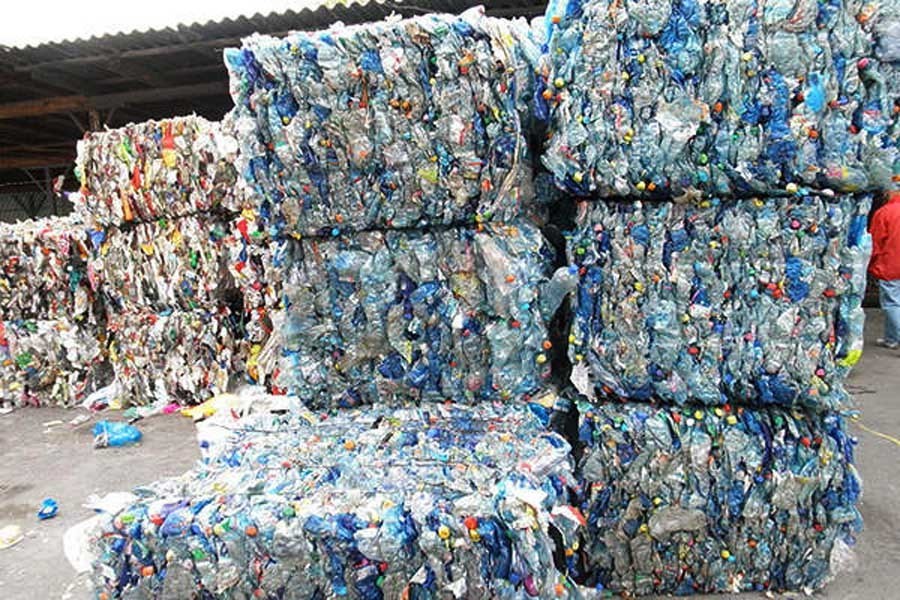It took rather too long for the government to finalise a plastic and packaging policy. Though still awaiting the government's nod, the draft appears to have addressed the key issues that in the absence of a well regulated system have for long been a cause for serious public worry about as well as uncertainty over the future of the plastic and packaging industry. Reports published in this newspaper say the policy aims at achieving competitiveness in producing plastic and packaging products for both domestic and overseas markets through facilitations including tax rebate, while also creating a congenial environment with technically-skilled human resources. The Ministry of Industries has prepared the draft 'National Plastic and Packaging Industry Development Policy 2019' with short and long-term action plans for the development of the growing sector.
One of the goals of the policy, reportedly, is to ensure a sustained 25 per cent growth of the sector by 2030. Besides, the policy aims at generating 0.5 million employment opportunities and boost contribution of plastic sector to the gross domestic product by at least two per cent by 2026. Broad goals of the policy are to increase investment in the sector, create quality infrastructure and ensure value addition and increase exports. The policy also recommends establishment of a plastic industrial park to ensure proper infrastructure, nurture small and medium enterprises, provide uninterrupted utility services, take steps to avoid environmental hazards and ensure compliance. Environmental Management System (EMS) has to be introduced in all plastic industrial units as a strategy and manage the environmental impact of the production facility, according to the draft.
Plastic industry, unlike most other industries, invites arguments both for and against the basic premise -- its presence as an evil or a blessing. The negative attitude is largely because of the many ill effects that are almost integrally linked to it. Currently, there are efforts, globally, towards cutting down the ill effects, and one hopes these succeed to the benefit of billions of people dependent on plastic products all over the world. Thus while one speaks about plastic, there are other things that come up too. One such is the poor or inadequate recycling of plastic waste. This is a scene common to most developing countries, and Bangladesh is no exception.
While pollution caused by plastic waste is tormenting the environment including aquatic resources necessitating urgent action, the reason why this manufacturing sector needs better management is increasingly felt at home and abroad.
The country's export of plastic goods is growing. However, the figures are not big enough to inspire great optimism. The fact remains that in Bangladesh, plastic plants have only recently opted for modern technology in producing various food and non-food grade products. With more technology backup and accompanying diversification, the industry -- though scattered and largely disorganised -- has the potential to grow extensively if provided with the right facilities. In this context, it may be noted that exporting was far from the targeted goal of the industry even a decade back, though there were few enterprises engaged in exporting in small volumes. Mainly it is the local demand that motivated factories-medium, small and very small-to produce plastic products.
The annual sales of plastic products in Bangladesh are currently estimated at around Tk 150 billion in the local market, in which household items account for nearly Tk 20 billion. Increase in domestic supplies reportedly grew at 15 per cent a year over the last several years. Industry insiders, quoted in recent newspaper reports, said the sector is experiencing fresh investment to the tune of Tk 1.0 -1.5 billion each year. The country's plastic sector is said to employ around 1.2 million people directly and indirectly in well over 4,500 small, medium and large manufacturing units producing plastic products of more than a dozen categories. Value addition in manufacturing is also commendably high, ranging between 50 and 70 per cent.
Use of plastic products in the country has grown manifold thanks to the dynamic improvements in recycling technology -- a key stimulus for increased production on the one hand and growing consumer preference on the other. However, a lack of upgrading quality and diversification in the product range is commonly attributed as the main impediment to the sector's growth to a far higher level. This holds true in respect of domestic consumption but more so, when it comes to exporting.
Global market of plastic is essentially demand-driven. Price structure of plastic products is highly wide-ranging, able to absorb immensely diversified products by the low, middle and up-end market segments.
Despite noticeable progress in this sector in Bangladesh, the concerned quarters consider this far from what it should have been. Major improvements in infrastructure, waste management, recycling and skills development are some of the critical areas in need of urgent attention to push the growth momentum to the desired level. In addition to these basics, product development and product adaptation should be attended to as a matter of priority. This, unfortunately, is an area many of the manufacturers miss out resulting in less than expected success in accessing overseas markets.
With the draft awaiting clearance soon, the industry will hopefully attract more attention than it urgently deserves, and measures and facilitations envisaged in it should initiate appropriate moves from both the concerned agencies as well as the industry itself.


